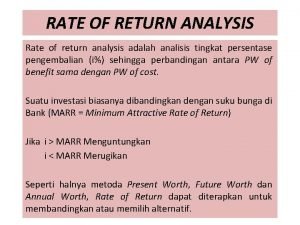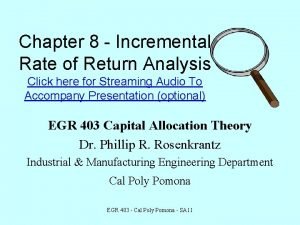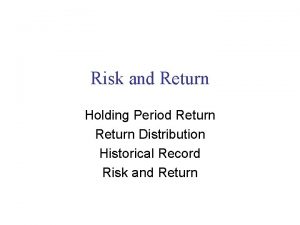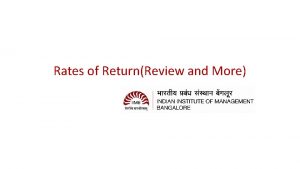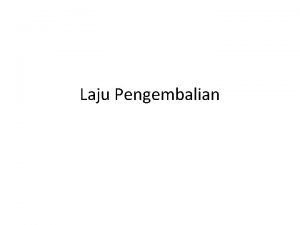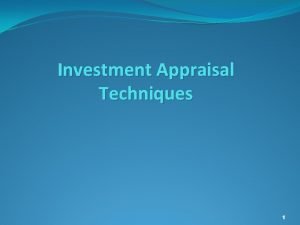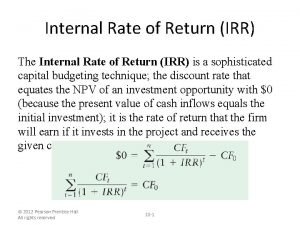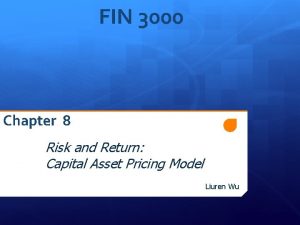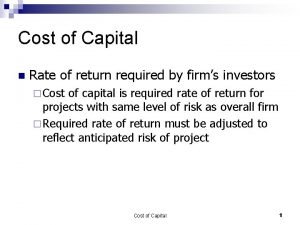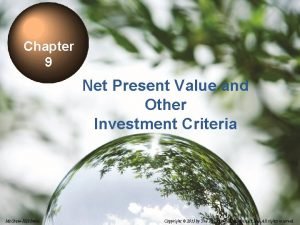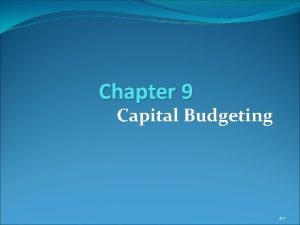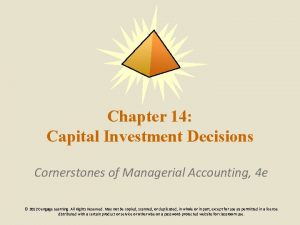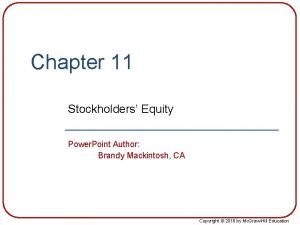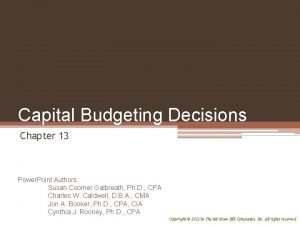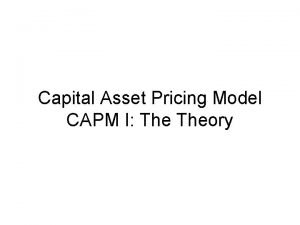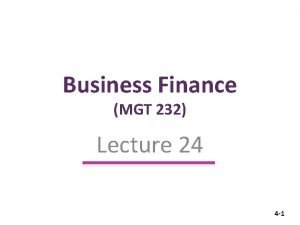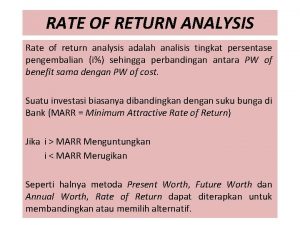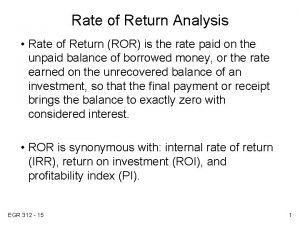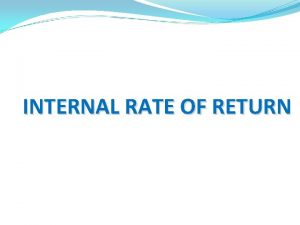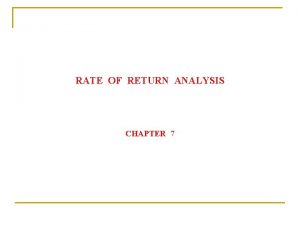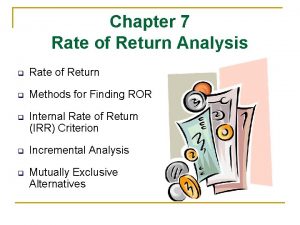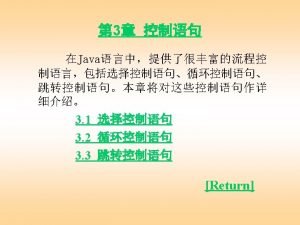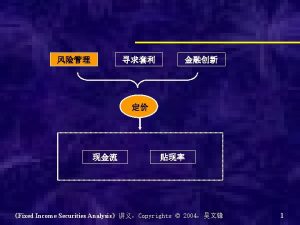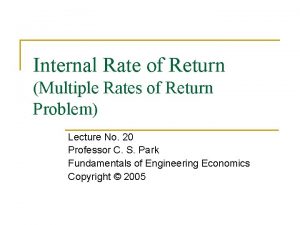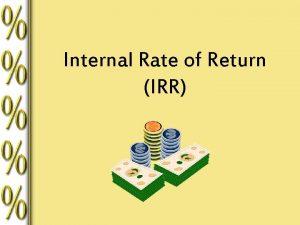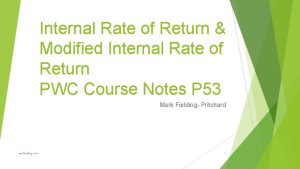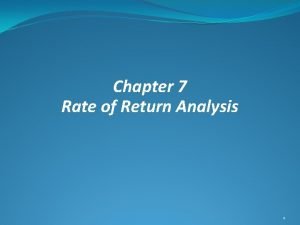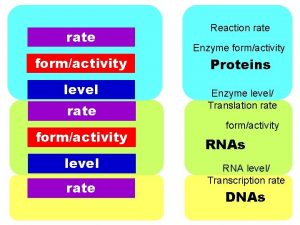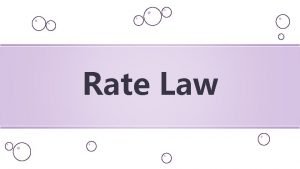Chapter 7 Rate of Return Analysis 1 n


















- Slides: 18

Chapter 7 Rate of Return Analysis 1

n n n Recall the $5, 000 debt example in chapter 3. Each of the four plans were used to repay the amount of $5000. At the end of 5 years, the principal and interest payments exactly repaid the $5000 debt with 8% interest. The total interest paid to the lender varied from $1200 to $2347. Despite this variation in total interest paid, we say that the lender received an 8% rate of return. Since we are describing situations of funds that remain within the investment throughout its life, the resulting rate is called the internal rate of return, i. 2

Calculating Rate of Return n n Convert the various consequences of the investment into a cash flow. Solve the cash flow for the unknown value of the internal rate of return (IRR). Use any of the following forms: 1. PW of benefits – PW of costs = 0 2. (PW of benefits)/(PW of costs) = 1 3. Net present worth = 0 4. EUAB – EUAC = 0 5. PW of costs = PW of benefits Any of the previous forms relate costs and benefits with the IRR as the only unknown. Rate of Return: It is the interest rate at which the benefits are equivalent to the costs 3

Example 7 -1 An $8200 investment returned $2000 per year over a 5 -year useful life. What was the rate of return on this investment? (PW of benefits)/(PW of costs) = 1 2000(P/A, i, 5)/8200 = 1 (P/A, i, 5) = 8200/2000 = 4. 1 Look at the compound interest tables for the value of i where (P/A, i, 5) = 4. 1. If no tabulated value exists, use interpolation. From the interest tables, one can find that for (P/A, i, 5) = 4. 1, i is 7%. (no interpolation was needed) The rate of return is exactly 7%. 4

Example 7 -2 An investment resulted in the following cash flow. Compute the rate of return. Year Cash Flow 0 1 2 3 4 –$700 +175 +250 +325 EUAB – EUAC = 0 100 + 75(A/G, i, 4) – 700(A/P, i, 4) = 0 Solve the equation by trial and error since we two unknown interest factors. Try i = 5% ►► 100 + 75(1. 439) – 700(0. 2820) = +11 Try i = 8% ►► 100 + 75(1. 404) – 700(0. 3019) = – 6 Try i = 7% ►► 100 + 75(1. 416) – 700(0. 2952) = 0 Therefore the IRR is exactly 7%. (Again, no interpolation was needed) 5

Example 7 -3 Calculate the rate of return on the investment on the following cash flow. Year 0 1 2 3 4 5 Cash Flow –$100 +20 +30 +20 +40 Use the form: NPW = 0 NPW = – 100 + 20(P/F, i, 1) + 30(P/F, i, 2) + 20(P/F, i, 3) + 40(P/F, i, 4) + 40(P/F, i, 5) Try i = 10% ►► NPW = – 100 + 20(P/F, 10%, 1) + 30(P/F, 10%, 2) + 20(P/F, 10%, 3) + 40(P/F, 10%, 4) + 40(P/F, 10%, 5) NPW = – 100 + 20(0. 9091) + 30(0. 8264) + 20(0. 7513) + 40(0. 6830) + 40(0. 6209) = +10. 16 Try i = 12% ►► NPW = – 100 + 20(0. 8929) + 30(0. 7972) + 20(0. 7118) +40(0. 6355) + 40(0. 5674) = +4. 126 Try i = 15% ►► NPW = – 100 + 20(0. 8969) + 30(0. 7561) + 20(0. 6575) +40(0. 5718) + 40(0. 4972) = – 4. 02 Therefore, the IRR lies between 12% and 15%. By linear interpolation, we 6 find that the IRR is: IRR = 13. 5%

Plot of NPW versus interest rate i: Cash Flow –P +benefit A +A +A. . . NPW Year 0 1 2 3. . . + For a cash flow representing investment followed by benefits from the investment, the plot of NPW versus i will decrease at a decreasing rate and have a zero value at unique value i (the interest rate at NPW = 0). i 0 – i Cash Flow +P – Repayment A –A –A. . NPW Year 0 1 2 3. . + For borrowed money, the NPW plot will increase at a decreasing rate and have a zero value at unique value i (the interest rate at NPW = 0). i 0 – i 7

Example 7 -4 A new corporate bond was initially sold by a stockbroker to an investor for $1000. The issuing corporation promised to pay the bondholder $40 interest on the $1000 face value of the bond every 6 months, and to repay $1000 at the end of 10 years. After one year the bond was sold by the original buyer for $950. a) What rate of return did the original buyer receive on his investment? b) What rate of return can the new buyer (paying $950) expect to receive if he keeps the bond for its remaining 9 -year life? 8

Rate of Return Analysis Motivating example Which alternative would you select? a) Using PW analysis Year 0 1 Alt. 1 –$10 +15 Alt. 2 –$20 +28 b) Using rate of return Use a Minimum Attractive Rate of Return (MARR) of 6%. a) Using PW analysis: Alt. 1: NPW = 15(P/F, 6%, 1) – 10 = 15(0. 9434) – 10 = 4. 15 Alt. 2: NPW = 28(P/F, 6%, 1) – 20 = 28(0. 9434) – 20 = 6. 415 Based on the PW analysis one should select Alt. 2. 9

…Rate of Return Analysis Year 0 1 b) Using Rate of Return: Alt. 1: PW of cost of Alt. 1 = PW of benefit of Alt. 1 10 = 15(1+ i )-1 ►► i = 50% i. e. the rate of return for Alt. 1 is 50% Alt. 1 –$10 +15 Alt. 2 –$20 +28 Alt. 2: PW of cost of Alt. 2 = PW of benefit of Alt. 2 20 = 28(1+ i )-1 ►► i = 40% i. e. the rate of return for Alt. 1 is 40% Based on the rate of return results one should select alternative 1, which contradicts with the PW analysis results. What should we follow; the PW analysis or the rate of return? 10

…Rate of Return Analysis Since we know that the PW analysis is correct, the previous example leads us to the conclusion that something went wrong in the rate of return approach. 11

…Rate of Return Analysis Consider the following statements about a project: 1. The net present worth of the project is $32, 000. 2. The equivalent uniform annual benefit is $2, 800. 3. The project will produce a 23% rate of return The third statement is perhaps most widely understood since it gives a measure of desirability of the project in terms that are readily understood. Therefore the Rate of return analysis is probably the most frequently used analysis Another advantage to rate of return analysis is that no interest rate is introduced in the calculations. Whereas both PW and annual cash flow methods require the use of an interest rate, which might be a difficult and controversial point. 12

…Rate of Return Analysis For one alternative: To determine the desirability of one alternative: 1. Compute the IRR from the cash flow 2. Compare the computed IRR with a preselected minimum attractive rate of return (MARR). The project is desirable if IRR≥MARR. 13

…Rate of Return Analysis When there are two alternatives, rate of return analysis is performed by computing the incremental rate of return ΔIRR on the difference between the alternatives. The difference can be: 1. Increments of Investment: Compute the ΔIRR on the increment of investment between the alternatives (i. e. the cash flow for the difference between the alternatives), which is computed by taking the higher initialcost alternative minus the lower initial-cost alternative. • Choose the higher-cost alternative if ΔIRR ≥ MARR • Choose the lower-cost alternative if ΔIRR < MARR 2. Increments of Borrowing: The reverse is done. I perfer that you always do increment of investment to minimize the confusion. 14

…Rate of Return Analysis Now let’s go back to the motivating example: Year 0 1 Alt. 1 –$10 +15 Alt. 2 –$20 +28 Alt. 2 – Alt. 1 –$20 – (–$10) = –$10 +28 – (+15) = +13 For the cost of differences cash flow (Alt. 2 – Alt. 1), compute the IRR: 10 = 13(P/F, i , 1) = 0. 7692 From the compound interest tables i = 30%. (OR you can just say an increase of $10 to $13 is 30% increase) Since ΔIRR ≥ MARR, choose Alternative 2. What happened was that the 30% rate of return on the difference between the alternatives is far higher than the 6% MARR. In other words, the additional $10 investment (at 30% IRR) is superior to investing the $10 elsewhere at 6%. 15

Example 7 -8 Solve the previous example using the increment Alt. 1 – Alt. 2: Year 0 1 Alt. 1 –$10 +15 Alt. 2 –$20 +28 Alt. 1 – Alt. 2 –$10 – (–$20) = +$10 +15 – (+28) = – 13 For the cost of differences cash flow (Alt. 1 – Alt. 2), compute the IRR: 10 = 13(P/F, i , 1) = 0. 7692 ►► i = 30% The cashflow (Alt. 1 – Alt. 2) represents a loan with a 30% interest rate. We know that the MARR is 6%, which also can be assumed our maximum interest rate on borrowing. We know that a 6% loan is preferred over a 30% loan. Therefore, the increment (Alt. 1 – Alt. 2) is undesirable. ►► Reject Alt. 1 and select Alt. 2 16

Example 7 -9 Year 0 1 2 3 4 5 Device A –$1000 +300 +300 Device B –$1000 +400 +350 +300 +250 +200 This problem has been solved before by the PW analysis (example 5 -1) Year 0 1 2 3 4 5 Device A –$1000 +300 +300 Device B –$1000 +400 +350 +300 +250 +200 Device A –Device B $0 – 100 – 50 0 +50 +100 …… 17

Analysis Period Two machines. MARR is 10%. Decide using the IRR comparison Machine X Initial cos $200 Uniform annual benefit 95 End of Useful live salvage value 50 Useful life (years) 6 Machine Y $700 120 150 12 The example is in your text. So, check the details PW of cost of differences = PW of benefits of differences 500 = 25(P/A, i, 12) + 150(P/F, i, 6) + 100(P/F, i, 12) The sum of benefits over the 12 years is $550 which is only a little greater than the $500 benefits, indicating that the rate of return is low. Try i = 1 % ►► 25(P/A, i, 12) + 150(P/F, i, 6) + 100(P/F, i, 12) = 511 Try i = 1. 5% ►► 25(P/A, i, 12) + 150(P/F, i, 6) + 100(P/F, i, 12) = 494 18 i. e the IRR on the Y-X increment (IRR ) is between 1% and 1. 5%
 Rate of return analysis
Rate of return analysis Incremental rate of return analysis
Incremental rate of return analysis Holding period return formula
Holding period return formula Real rate of return
Real rate of return Return adalah
Return adalah Calculate arr
Calculate arr How to find internal rate of return
How to find internal rate of return Fin 3000
Fin 3000 Requi
Requi Profitability index ba ii plus
Profitability index ba ii plus Npv ti 83
Npv ti 83 Expected rate of return capm
Expected rate of return capm External rate of return
External rate of return Required return on investment formula
Required return on investment formula Accounting rate of return formula
Accounting rate of return formula Return on common stockholders’ equity
Return on common stockholders’ equity Internal rate of return method
Internal rate of return method Capm rate of return
Capm rate of return Rate of return on equity
Rate of return on equity
